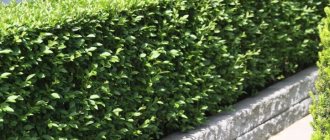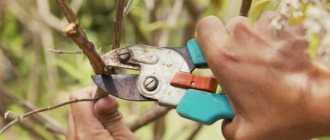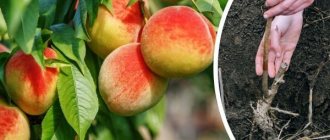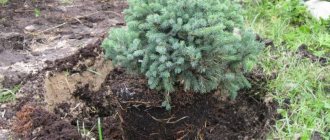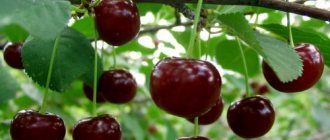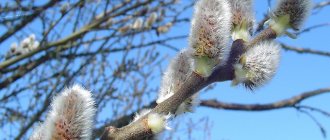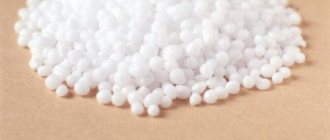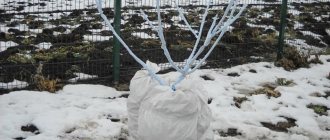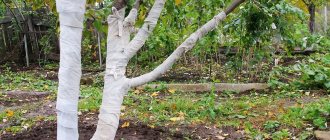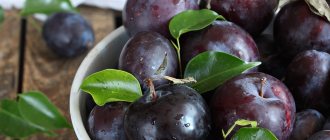Why prune a peach in the fall, what does it give?
Any plant, including the peach tree, gets its nutrients from the soil . They pass through the trunk and are distributed among the branches. The peculiarity of the peach is that this process takes place faster in it than in other plants.
If you ignore pruning, the crown will become too thick and the branches located in the center will no longer receive enough sunlight and nutrients.
Important! Pruning increases the plant's yield and extends its life.
If you do not carry out this procedure, the tree will look sloppy, the branches will grow chaotically, and harvesting from such a tree will be much more difficult.
Sheltering a peach for the winter
Attention! Peach is a delicate, demanding and delicate crop. He is very afraid of strong drops in air temperatures and cold, piercing winter hurricanes. Therefore, it is necessary to form protection for the roots, trunk, root collar and crown.
Video: preparing peach for winter shelter
Proper preparation will allow the tree to survive any frost without loss. To do this, you should perform the following activities:
- Dig up the soil next to the trunk and water it . Moisture, thanks to the loosened soil, will flow to a depth of 1 meter. This will allow the roots, provided with nutrient water, to freeze less.
- Spray with fungicides or Bordeaux mixture to prevent the appearance of pests and diseases.
- Mulch the area under the crown - fallen leaves, sawdust, and humus are suitable for this. The procedure is carried out after frost in dry weather.
- Insulation with burlap - it is wrapped around the trunk in several layers.
- Protecting the peach crown from frost - it is better to erect supports next to the tree and wrap the crown with covering material. Any material is suitable for this - roofing felt, thick paper, old wallpaper, agrofibre. You should not use polyethylene; condensation often forms under it, which promotes rotting and the appearance of fungus.
Video: how to cover a peach for the winter with spunbond
This peach shelter for the winter is made with all varieties of fruit crops. Differences between species are not highlighted. A well-insulated tree can overwinter warmly, without diseases or pests. The main thing is to bloom abundantly in the spring.
Video: how to prepare and cover a young peach for the winter
Optimal timing of the procedure
Pruning is stressful for every plant . Pruning in the spring will cause a significant reduction in yield for the current season. But even at this time it has its own significance: it is aimed at forming the correct crown of the tree, which will provide access to sunlight to all branches and make it easier for the gardener to harvest in the future.
Autumn pruning is considered safer. The vegetative processes of the plant slow down significantly - it prepares for the cold, so the tree can more easily withstand injury. In the autumn, they shorten and reduce the number of fruiting branches. The main task of autumn pruning is to prepare the plant for wintering.
Reference. The optimal time for autumn pruning is after harvest and before October 15. Spring pruning is carried out from mid-March to April 20.
Trim date selection
When figuring out when it is best to prune a plant, you should take into account the goals of the procedure. Trimming is stressful for any tree, so you need to take into account all the details of the manipulation in advance.
When deciding whether a peach can be pruned in the fall, take into account the region of residence. The procedure is carried out in summer, spring and autumn. Each manipulation has its own importance. Autumn haircuts are safer than those done at any other time. The planting begins to prepare for wintering and easily tolerates the procedure.
Note!
The best time for a haircut is from early September to mid-October. This period is relevant for the southern regions. In other areas, it is better to trim in September.
The main thing is that pruning of young peach in the fall should be carried out before the cold snap. Haircutting is strictly prohibited when the temperature reaches zero at night. This must be taken into account when deciding when it is better to prune a peach in the fall and in what month.
How to properly trim a peach
If you follow the rules and use high-quality equipment, pruning is an absolutely safe procedure for peach.
Required materials and tools
To carry out pruning you will need pruning shears, a garden saw, a lopper, and a garden knife.
Important! All tools must be well sharpened and immediately before work they are treated with an antiseptic.
Trimming scheme
Pruning is performed annually according to the following scheme.
1 year
Reduce the height of the one-year-old seedling to 50 cm. There should be 2 large branches or developed buds on the remaining part of the tree. They are tied to thin slats so that they are located at an angle of 45° to the trunk. From the remaining lateral branches, one upper bud is cut off.
2 years
It is considered ideal if the next year these side shoots grow 50 cm. If this does not happen, then the central shoot is cut to the place where these branches extend from the main trunk.
If the length of the branches is less than 40 cm, then they are cut off to the last growth or triple bud, which is as far as possible from the trunk. On these branches, 2 developed shoots are selected and tied to the same rail. The remaining shoots are cut back to the leaf closest to the main shoot.
3 years
Next fall, all large branches are shortened by about a third. Then, 3 shoots are selected from them and all growth buds directed downwards are removed. These branches are tied to a rail, and the rest are cut to the first leaf.
4 years
If the pruning was done correctly, the tree will please the gardener with a good harvest in the fourth year. Most often, peaches are planted near walls. All shoots directed perpendicular to the wall are removed, with the exception of those on which flowers appear in the fall - at least 2 leaves are left on them.
Step-by-step pruning instructions
Pruning includes several stages:
- Sanitation. Remove all shoots and branches that have defects and damage.
- Shortening shoots. All shoots of the tree are pruned - those that make up the frame and those that bear fruit.
- Pruning vulnerable branches. The structure of the tree is assessed and fragile and vulnerable branches are completely removed.
Tree formation
It is recommended to strive to form the peach crown in the form of a bush - this is due to the peculiarities of the movement of nutrients through the tree. In addition, this shape contributes to the uniform distribution of sunlight across all branches.
Optimal tree parameters:
- lower tier – 20 cm;
- standard – 50-60 cm;
- between the bases – 3-4 skeletal branches;
- on each branch - 2 semi-skeletal branches of the second order at a distance of at least 30 cm from each other;
- above the first tier - a second tier of semi-skeletal branches, up to 5 pcs.
Required inventory
Before cutting, you need to prepare the necessary tools. They must be cleaned, sharpened, and in full working order. Equipment must be disinfected and sterilized in order to:
- do not cause unnecessary injuries to the tree;
- eliminate the possibility of infection.
The tool is soaked in a saturated solution of potassium permanganate, completely immersing the cutting edges in it for half an hour. Then remove it and let it dry.
To prune the branches of a fruit tree, you will need:
- pruner;
- lopper;
- garden saw;
- garden knife;
- wood scissors.
Dry instruments are treated with alcohol. You can trim the peach after the traces of processing have evaporated.
Features of pruning young and old trees
The procedure has its own characteristics for trees of different ages.
young tree
All manipulations are done carefully. Excessive removal of branches can destroy the plant.
Rules:
- The main shoot is pinched if there are young shoots on the seedlings;
- when planting a tree, only 3-4 shoots pointing downwards are left, all the rest are removed;
- branches located in the center are cut as short as possible in the third year.
Old tree
The specifics of pruning an old peach depend on how carefully the owner cared for it. If the tree has not received enough attention, you will have to remove not only small, but also large branches, and sometimes even parts of the tree. However, even an old tree can be brought back to life with pruning.
Peach pruning technology
The technology for autumn pruning of peach trees depends on many nuances. They take into account the age of the tree, its condition, crown shape, climate, etc. Up to 5 years, a peach tree is considered young, and after 5 – old.
Types of pruning
Pruning allows you to solve several problems at once. To decide which branches to trim, you need to decide on your goals. Some trees need rejuvenation, others need to get rid of excess shoots.
There are two main functions of trimming:
- Thinning. The branch is completely removed - old, diseased, dry. Thinning procedures have virtually no effect on yield. Their task is to rejuvenate the peach and give it new strength.
- Shortening. It can be weak, moderate or strong. In the first case, a quarter of the length is removed from 5% of the branches. In the second, a third of the length is removed from 10%; in the third, half the length is removed from 20%.
Depending on the goals pursued and the technique of implementation, the following types of pruning are distinguished:
- Rejuvenating. Conducted from the age of two. Up to 20% of shoots are pruned. If you remove more, the tree may die.
- Sanitary. Remove all affected branches. Frozen, damaged by insects and diseases, dried out, broken.
- Formative. It consists of creating a crown of a certain shape by trimming certain branches.
- Restorative. Used when the crown is frozen or damaged by various natural disasters. This is a radical option that involves removing all damaged parts of the tree.
- Differentiated. Thinning the top of the crown in order to stimulate development. Used on peaches for 5-10 years.
Young and old peaches
The main principle of pruning is caution. You cannot prune branches indiscriminately. It is necessary to shape the crown and remember that excessive zeal can destroy the peach.
How to trim a young peach:
- the central shoot can be pinched if there are young branches on it;
- when planting seedlings, leave up to 4 branches;
- In the 3rd year of life, the central branches are cut as short as possible.
Processing of sections and further care
Since the procedure is very traumatic, they pay attention to the correct pruning technique and provide the tree with further care.
The cut areas are treated with garden varnish so that infection does not get there and they heal faster. The sections are processed one day after the procedure.
Further care consists of ensuring regular hydration, fertilizing and preventing parasite invasion.
After autumn pruning, winter watering is carried out: it increases the winter hardiness of the tree. Water consumption: 90-100 l per 1 m² of tree trunk circle.
Caring for peach involves adding fertilizers to the soil, the quality and composition of which depends on the characteristics of the soil. Poor soil is fertilized every year, but fertile soil needs to be fertilized once every 2-3 years. In autumn, 40 g of superphosphate and 50 g of calcium chloride per 1 m² are added to the soil. Once every 2-3 years, the plant is fed with organic fertilizers: humus or compost.
In order to prevent the fight against parasites (aphids, fruit moths, codling moths) and fungi, the peach tree is treated with a 7% urea solution or a 1% copper sulfate solution before wintering.
Choosing the right time: spring, summer or autumn?
Peach pruning begins from the 2nd year of life . By this time, the plant has already “opened” - it has several side shoots. From these, future skeletal branches are selected.
There is no particular point in starting pruning earlier. Of course, pinching the top will stimulate the growth of side branches .
However, if you grab too much, the shoots will go at an acute angle to the guide. Correcting such a tree will take additional time.
Peach is one of the crops that need to be pruned in spring, summer, and autumn .
| Spring | Formation of the seedling crown. Restorative pruning with removal of frozen shoots. Rejuvenating pruning of old trees. |
| Summer | Removing dead shoots that go unnoticed in the spring. Shortening weak fruiting branches. Thinning out the “tops” and removing thickening shoots. Sanitary pruning of shoots affected by diseases and pests. Shortening the current year's growths for their better ripening. |
| Autumn | Sanitary pruning of diseased shoots. Removing branches broken off by the harvest. |
Experienced peach growers recommend counting the branches remaining after autumn pruning. There should be no more than eighty of them left.
The nuances of pruning by region
Features of pruning depend on the regions in which the plant is grown.
Crimea, Kuban
In the warmest regions, early varieties of peaches are common. They are pruned in March. The crown is given a cup-shaped shape, ensuring uniform illumination of all branches. Fruit branches are shortened, stimulating the appearance of new shoots.
Central Russia
In regions with a temperate climate, the procedure is carried out in late March - early April. They are formed in the form of a bush with developed lower shoots, which are removed after fruiting.
Northern regions
In areas with cold climates, seedlings are planted at an angle of 45°. They create a trunk with two large branches that bear fruit alternately and cover it for the winter. Everything else is cut off.
This is interesting:
Beginner's Guide: How to Care for Potted Pomegranates at Home.
A step-by-step guide to propagating pomegranate from cuttings at home.
A step-by-step guide to pruning sea buckthorn in the fall.
Origin and distribution of the peach
Scientists have not reliably found out where the geographical homeland of the peach is. There is a version that this is a cultivated species of Prunus davidiana Franch., found in Northern China. It is also known that peaches began to be grown in European gardens back in the 1st century AD. (in Italy). Currently cultivated in all regions of the subtropical zone and in the warmer parts of the temperate zone. However, China remains the main producer. Russia, in terms of peach cultivation, is not even among the top twenty leading producers, which, in general, is explained by the very limited area on which peaches can produce good harvests (the south of the Krasnodar and Stavropol territories).
Tips for the garden, vegetable garden and flower garden
Pruning cherries in the fall for beginners in pictures step by step
Pruning plums in the fall for beginners in pictures step by step
Pruning cherries in autumn for beginners in pictures step by step
